 BMW R 1250 RT - Owner's Manual > Riding mode
BMW R 1250 RT - Owner's Manual > Riding mode
Riding mode selection
In order to adapt the motorcycle to weather conditions, road conditions and the rider's riding style, there is a choice of three riding modes:
- RAIN
- ROAD
- with riding modes Pro OE
- DYNAMIC
Each of these modes produces perceptible differences in the way the motorcycle behaves. ASC/ DTC can be switched off in each mode; the following explanations always relate to the switched-on system. The mode last selected is automatically reactivated after the ignition has been switched off and then on again.
Broadly speaking: The more dynamic the selected mode, the more ASC/DTC assistance is reduced.
Consequently, you must always bear the following in mind with regard to your selection of a ride mode: the more dynamic the setting, the greater the challenge to your riding skill.
Throttle response:
- In the RAIN mode: Restrained
- In the ROAD mode: Direct
- with riding modes Pro OE
- In the DYNAMIC mode: Dynamic
RAIN mode
The ASC/DTC system intervenes early enough to prevent the rear wheel from spinning. On roads with a high to medium coefficient of friction (dry and wet asphalt to dry cobblestones), the motorcycle remains very stable; movements of the rear are clearly perceptible only on slippery roads (wet bitumen or wet cobblestones).
ROAD mode
ASC/DTC system intervention is later than in RAIN mode. On roads with a high to medium coefficient of friction (dry and wet asphalt to dry cobblestones), the motorcycle remains stable.
Slight rear-wheel drift is perceptible.
Movements of the rear are clearly perceptible on slippery roads (wet bitumen or wet cobblestones).
- with riding modes Pro OE
DYNAMIC mode
The DYNAMIC mode is the sportiest mode.
The ASC/DTC system intervenes even later, which means that, even on dry asphalt, drifting is possible under sharp acceleration when cornering.
ABS
- The rear wheel lifting assistant is active in all modes.
- ABS is tailored to on-road operation.
- In RAIN, ROAD and DYNAMIC riding modes, ABS Pro is fully available. The
tendency of the motorcycle to straighten up when the brakes are applied with
the machine banked for cornering is reduced to a minimum.
- with Dynamic ESA OE
Dynamic ESA
Basic setting in:
- RAIN: ROAD
- ROAD: ROAD
- with riding modes Pro OE
- DYNAMIC: DYNA
Changeover of the riding modes
The changeover of the functions in the engine control and the ASC/DTC is only possible if there is no drive torque at the rear wheel.
- In order to achieve this state, the motorcycle must be at a standstill with the ignition switched on
or
- the throttle grip must be turned back and brakes must not be applied.
Dynamic Brake Control
- with riding modes Pro OE
Dynamic Brake Control function
The Dynamic Brake Control function assists the rider during emergency braking.
Detection of emergency braking
- Emergency braking is detected when the front brake is actuated quickly and forcefully.
Behaviour during emergency braking
- If emergency braking is initiated at a speed above 10 km/h, the Dynamic Brake Control takes effect in addition to the ABS function.
- If partial braking at high brake pressure gradients is initiated, the Dynamic Brake Control increases the integral brake pressure on the rear wheel. The stopping distance shortens and controlled braking is possible.
Behaviour during accidental actuation of the throttle grip
- If, during emergency braking, the throttle grip is accidentally actuated (grip position > 5 %), the actual braking effect caused by the Dynamic Brake Control is guaranteed by closing the gas. The effect of emergency braking is guaranteed.
- If, during the intervention of the Dynamic Brake Control, the gas is closed (throttle grip position < 5 %), the engine torque requested by the ABS brake system is restored.
- If emergency braking finishes and the throttle grip is still actuated, the Dynamic Brake Control will reduce the engine torque to the driver's choice in a controlled manner.
Tyre pressure control (RDC)
- with tyre pressure control (RDC) OE
Function
A sensor integrated into each tyre measures the air temperature and the air pressure inside the tyre and transmits this information to the control unit.
The sensors are fitted with a centrifugal-force tripswitch which allows the measured values to be transmitted after the minimum speed is exceeded the first time.
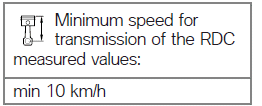
The display shows "--" for each tyre until the tyre pressure signal is received for the first time. The sensors continue to transmit the measured-value signals for some time after the vehicle comes to a stop.
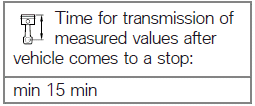
An error message is issued if wheels without sensors are fitted to a vehicle equipped with an RDC control unit.
Tyre pressure ranges
The RDC control unit distinguishes between three tyre pressure ranges matched to the vehicle:
- Filling pressure within the permissible tolerance
- Filling pressure in the limit range of the permissible tolerance
- Filling pressure outside permitted tolerance
Temperature compensation
Tyre pressure is a temperature-sensitive variable: pressure increases as tyre-air temperature rises and decreases as tyre-air temperature drops. Tyre-air temperature depends on ambient temperature as well as on the style of riding and the duration of the ride.
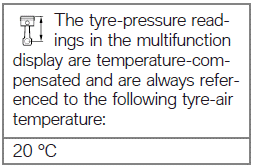
The air lines available to the public in petrol stations and motorway service areas have gauges that do not compensate for temperature; the reading shown by a gauge of this nature is the temperature-dependent tyre-air pressure. In most instances, therefore, these gauge readings will not tally with the pressures shown by the multifunction display.
Pressure adaptation
Compare the RDC value on the multifunction display with the value in the table on the back cover of the Rider's Manual.
Then use the air-line gauge at a service station to compensate for the difference between the RDC reading and the value in the table.
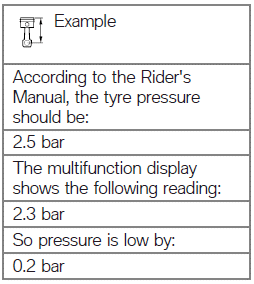
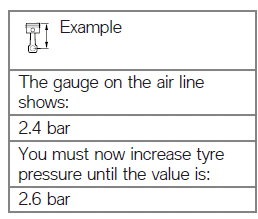
See also:
 BMW R 1250 RT - Owner's Manual > Traction control (ASC/DTC)
BMW R 1250 RT - Owner's Manual > Traction control (ASC/DTC)
How does ASC/DTC work? BMW Motorrad ASC/DTC compares the wheel speeds at the front and rear wheel. The differential is used to compute slip as a measure of the reserves of stability available at the rear wheel.
 BMW R 1250 RT - Owner's Manual > Shift assistant
BMW R 1250 RT - Owner's Manual > Shift assistant
with shift assistant Pro OE Shift assistant Pro Your vehicle is equipped with a Pro shift assistant, a system originally developed for racing and now adapted for touring. It permits upshifts and downshifts without declutching or closing the throttle in virtually all load and rpm ranges.
 BMW R 1250 RT
BMW R 1250 RT Kymco Agility 50
Kymco Agility 50 Piaggio Liberty 50
Piaggio Liberty 50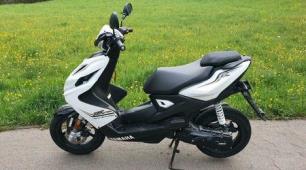 Yamaha aerox NS50
Yamaha aerox NS50 Aprilia SR50R
Aprilia SR50R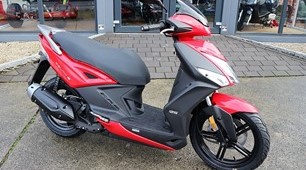 Kymco Agility 50
Kymco Agility 50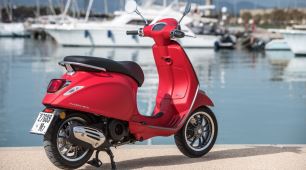 Vespa Primavera 50
Vespa Primavera 50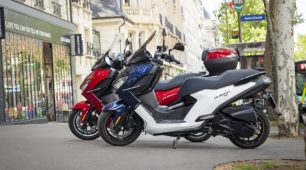 Peugeot Speedfight
Peugeot Speedfight